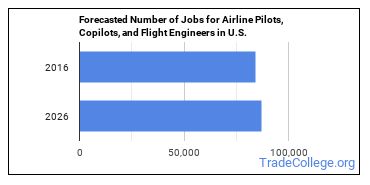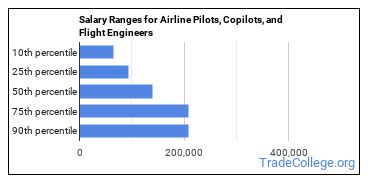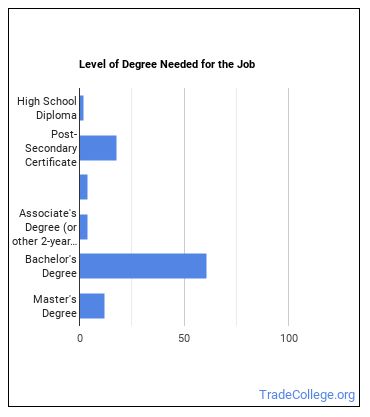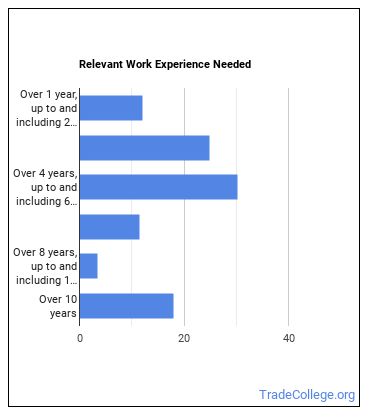Find Trade Colleges
What is an Airline Pilot, Copilot, or Flight Engineer?
Airline Pilot, Copilot, or Flight Engineer Example Pilot and navigate the flight of fixed-wing, multi-engine aircraft, usually on scheduled air carrier routes, for the transport of passengers and cargo. Requires Federal Air Transport Pilot certificate and rating for specific aircraft type used. Includes regional, National, and international airline pilots and flight instructors of airline pilots.
Daily Life Of an Airline Pilot, Copilot, or Flight Engineer
- Load smaller aircraft, handling passenger luggage and supervising refueling.
- Coordinate flight activities with ground crews and air traffic control and inform crew members of flight and test procedures.
- Respond to and report in-flight emergencies and malfunctions.
- Instruct other pilots and student pilots in aircraft operations and the principles of flight.
- Make announcements regarding flights, using public address systems.
- Perform minor maintenance work, or arrange for major maintenance.
Featured schools near , edit
Airline Pilot, Copilot, or Flight Engineer Required Skills
When polled, Airline Pilots, Copilots, and Flight Engineers say the following skills are most frequently used in their jobs:
Operation and Control: Controlling operations of equipment or systems.
Operation Monitoring: Watching gauges, dials, or other indicators to make sure a machine is working properly.
Active Listening: Giving full attention to what other people are saying, taking time to understand the points being made, asking questions as appropriate, and not interrupting at inappropriate times.
Monitoring: Monitoring/Assessing performance of yourself, other individuals, or organizations to make improvements or take corrective action.
Critical Thinking: Using logic and reasoning to identify the strengths and weaknesses of alternative solutions, conclusions or approaches to problems.
Speaking: Talking to others to convey information effectively.
Types of Airline Pilot, Copilot, or Flight Engineer
- Astronaut
- Navy Fighter Pilot
- Regional Airline Pilot
- Systems Navigator
- Airline Pilot (Captain)
Is There Job Demand for Airline Pilots, Copilots, and Flight Engineers?
There were about 84,000 jobs for Airline Pilot, Copilot, or Flight Engineer in 2016 (in the United States). New jobs are being produced at a rate of 3.5% which is below the national average. The Bureau of Labor Statistics predicts 2,900 new jobs for Airline Pilot, Copilot, or Flight Engineer by 2026. The BLS estimates 8,100 yearly job openings in this field.

The states with the most job growth for Airline Pilot, Copilot, or Flight Engineer are Florida, New Jersey, and Georgia. Watch out if you plan on working in Wyoming, West Virginia, or New Hampshire. These states have the worst job growth for this type of profession.
How Much Does an Airline Pilot, Copilot, or Flight Engineer Make?
The average yearly salary of an Airline Pilot, Copilot, or Flight Engineer ranges between $65,690 and $208,000.

Airline Pilots, Copilots, and Flight Engineers who work in Michigan, Nevada, or Oregon, make the highest salaries.
How much do Airline Pilots, Copilots, and Flight Engineers make in each U.S. state?
| State | Annual Mean Salary |
|---|---|
| Alabama | $103,750 |
| Alaska | $148,820 |
| Arizona | $132,250 |
| Arkansas | $96,690 |
| California | $205,520 |
| Colorado | $196,670 |
| Connecticut | $116,930 |
| Florida | $188,400 |
| Illinois | $193,600 |
| Indiana | $124,270 |
| Iowa | $118,700 |
| Kansas | $102,190 |
| Louisiana | $101,010 |
| Michigan | $233,550 |
| Minnesota | $103,930 |
| Mississippi | $94,760 |
| Missouri | $123,820 |
| Nebraska | $106,480 |
| Nevada | $220,400 |
| New Hampshire | $122,810 |
| New Mexico | $163,030 |
| New York | $108,420 |
| North Carolina | $102,660 |
| North Dakota | $104,660 |
| Ohio | $119,320 |
| Oklahoma | $107,960 |
| Oregon | $205,660 |
| Pennsylvania | $151,390 |
| South Carolina | $102,990 |
| Tennessee | $85,550 |
| Texas | $200,320 |
| Utah | $104,230 |
| Washington | $237,150 |
| West Virginia | $85,490 |
| Wisconsin | $106,240 |
What Tools & Technology do Airline Pilots, Copilots, and Flight Engineers Use?
Below is a list of the types of tools and technologies that Airline Pilots, Copilots, and Flight Engineers may use on a daily basis:
- Microsoft Excel
- Microsoft Word
- Microsoft Office
- Microsoft PowerPoint
- Microsoft Outlook
- Microsoft Visio
- SBS International Maestro Suite
- RMS Technology Flitesoft
- MJICCS PilotLog
- Nimblefeet Technologies Captain’s Keeper
- Electronic aircraft information databases
- Polaris Microsystems CharterLog
- AirSmith FlightPrompt
- Skylog Services Skylog Pro
- doXstor Flight Level Logbook
- AeroPlanner
- Notam Development Group Airport Insight
- Navzilla
- Pilot Navigator Software Load Balance
- Polaris Microsystems AeroLog Pro
Becoming an Airline Pilot, Copilot, or Flight Engineer
What education or degrees do I need to become an Airline Pilot, Copilot, or Flight Engineer?

What work experience do I need to become an Airline Pilot, Copilot, or Flight Engineer?

References:
Image Credit: Tech. Sgt. Scott T. Sturkol via U.S. Air Force photo
More about our data sources and methodologies.
